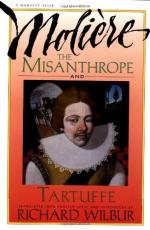|
This section contains 2,057 words (approx. 7 pages at 300 words per page) |

|
SOURCE: “Love and Friendship in Le Misanthrope,” in Romance Notes, Vol. XXIII, No. 2, Winter, 1982, pp. 164-69.
In the following essay, Jones explores the polarities of the characters in Molière's Le Misanthrope.
Two fundamental contrasts strike the audience of Le Misanthrope: the contrast between Alceste and Célimène, and the contrast between Alceste and Philinte. Critics have been sensitive to the psychological, philosophical, and theatrical value of these polarities. “Alceste est l'exacte antithèse de Célimène,”1 declares Jean Mesnard, while Jacques Guicharnaud defines the hero and his love as “deux univers soumis à quelque attraction réciproque, mais dont les éléments imcompatibles ne parviennent à aucun moment à fusionner.”2 Guicharnaud suggests that Célimène's dramatic function is to “s'opposer point par point à Alceste sur le plan de l'amour, comme Philinte … sur le plan de l'amitié …” (p. 396).
Philinte, indeed, has been viewed almost exclusively as a foil...
|
This section contains 2,057 words (approx. 7 pages at 300 words per page) |

|


